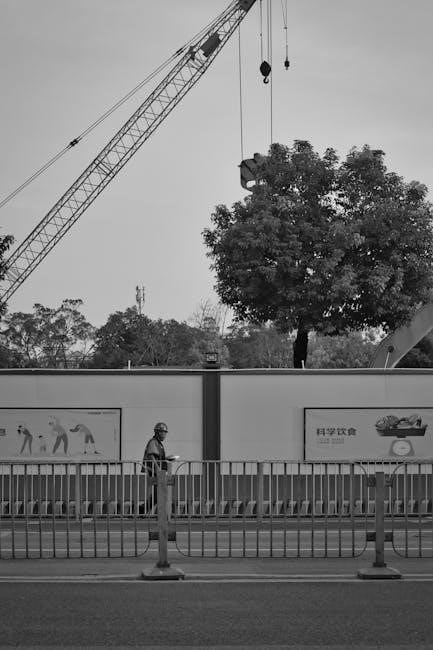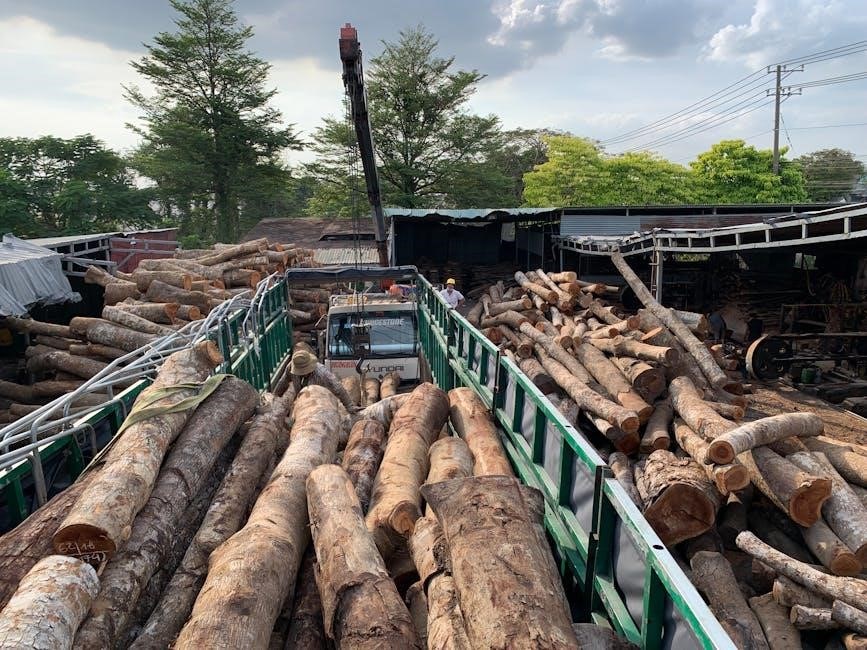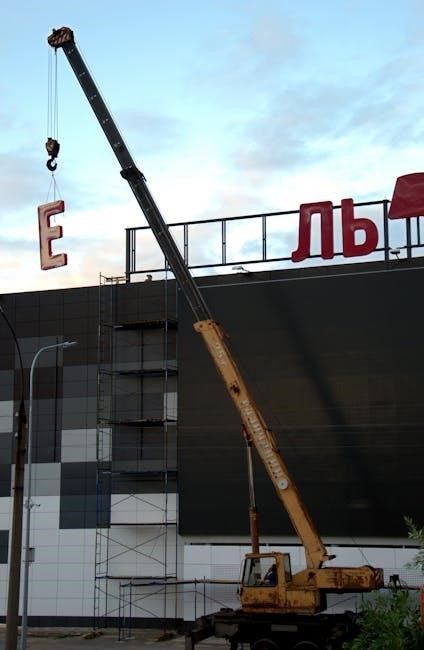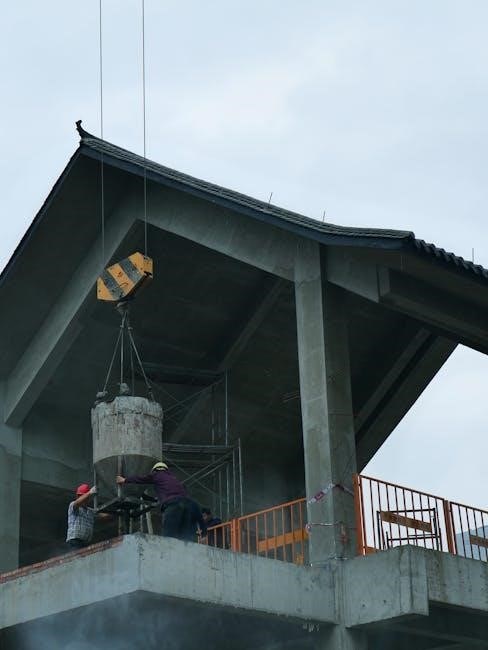
manual crane
Manual cranes are lifting equipment operated without electric power, commonly used in industrial environments and workshops․ They offer a simple, cost-effective solution for material handling needs, with types like single girder, double girder, and gantry cranes available․
Definition and Purpose
A manual crane is a type of lifting equipment operated by hand, typically using chains or wire ropes, without relying on electric or hydraulic power․ Its primary purpose is to lift and move loads in industrial, construction, or marine settings․ Designed for simplicity, manual cranes are cost-effective solutions for material handling, offering precise control and flexibility․ They are ideal for environments where power availability is limited or where lightweight, portable lifting systems are required․ Manual cranes are widely used in workshops, small-scale operations, and specific industrial applications due to their ease of use and low maintenance requirements․
Historical Background
Manual cranes trace their origins to ancient civilizations, where rudimentary pulleys and levers were used for lifting․ Over centuries, their design evolved, becoming integral to construction and trade․ The Industrial Revolution brought standardization, enhancing their functionality and accessibility․ Today, manual cranes remain essential in various industries, valued for their simplicity, cost-effectiveness, and reliability in environments without power access․ Their enduring relevance underscores their historical significance in material handling and engineering․
Importance in Material Handling
Manual cranes play a vital role in material handling, offering a cost-effective and reliable solution for lifting and moving loads in various environments․ Their simplicity and ease of operation make them ideal for small-scale operations, workshops, and construction sites․ Unlike powered cranes, manual cranes require minimal setup and maintenance, reducing operational costs․ They provide flexibility in areas where electricity is unavailable, ensuring efficient material movement․ Their durability and versatility make them indispensable in industries requiring consistent, low-maintenance lifting solutions, enhancing productivity and safety in daily operations․

Types of Manual Cranes
Manual cranes include single girder, double girder, gantry, jib, and chain hoist types, each designed for specific lifting tasks efficiently in various industrial settings․
Manual Single Girder Overhead Crane
A manual single girder overhead crane features a single horizontal beam supported by two end trucks, allowing for smooth lateral movement․ It is operated using a hand chain or wire rope, offering precise control for lifting and positioning loads․ This crane is ideal for light to medium-duty applications, such as workshops or small-scale industrial settings, where cost-effectiveness and simplicity are prioritized․ Its compact design ensures efficient use of space while maintaining reliable performance in various material handling tasks․
Manual Double Girder Overhead Crane
A manual double girder overhead crane consists of two horizontal beams and a trolley running mechanism, offering enhanced stability for heavier loads․ It is equipped with a manual trolley and hand-pulled lifting mechanism, making it suitable for industrial environments requiring precise control․ This crane is ideal for applications where manual operation is preferred, providing reliable performance for medium-duty material handling tasks․ Its durable design ensures longevity, while its operational simplicity makes it a practical choice for workshops and facilities with specific lifting needs․
Manual Gantry Crane
A manual gantry crane is a portable lifting solution with a sturdy A-frame or U-shaped design, ideal for lighter loads in workshops or construction sites․ Equipped with a hand chain or wire rope hoist, it allows for vertical lifting and lateral movement without the need for electricity․ Its fixed rubber casters provide stability, making it suitable for environments where crane installation is temporary․ This crane is cost-effective and easy to install, offering versatility for small-scale material handling tasks where manual operation is preferred․
Manual Jib Crane
A manual jib crane is a lightweight lifting solution ideal for workshops and small-scale operations․ Featuring an A-frame or wall-mounted design, it is operated by hand, using a chain or wire rope hoist for vertical lifting․ Its compact structure allows for easy installation and portability, making it suitable for environments with limited space․ Commonly used for lighter loads, manual jib cranes are cost-effective and require minimal maintenance, providing a reliable option for small material handling tasks where manual operation is practical and efficient․
Manual Chain Hoist Crane
A manual chain hoist crane is a versatile lifting device operated by hand, utilizing a chain or wire rope to raise and lower loads․ It is commonly used in industrial and marine environments for its portability and ease of use․ This crane is equipped with a geared trolley and fixed rubber casters, allowing smooth movement along runways․ The manual winding system ensures precise control, while the hand chain or wire rope provides reliable lifting capabilities․ Ideal for flexible material handling, it is a cost-effective solution requiring minimal maintenance and installation efforts, making it suitable for various lifting tasks where manual operation is preferred․
Manual Lever Hoist Crane
A manual lever hoist crane is a portable, hand-operated lifting device that uses a lever to engage gears for hoisting․ It is ideal for environments without electrical power, offering a simple and reliable solution for lifting loads․ The lever hoist operates by manually moving the lever up and down, providing precise control over the load․ This crane is lightweight, easy to install, and requires minimal maintenance, making it suitable for workshops, construction sites, and marine applications․ Its durability and cost-effectiveness ensure efficient material handling in various settings․

Components of Manual Cranes
Manual cranes consist of key components like the trolley, hoisting mechanism, manual winding system, hand chain or wire rope, geared trolley, and fixed rubber casters, ensuring smooth operation․
Trolley and Hoisting Mechanism
The trolley and hoisting mechanism are central to manual cranes, enabling load movement along the runway․ The trolley, mounted on the crane’s girder, features wheels that glide smoothly, ensuring precise positioning․ The hoisting mechanism, operated by hand, typically involves a chain or wire rope, which lifts and lowers loads․ This system is designed for durability and efficiency, allowing operators to handle materials safely and effectively in various industrial settings․ Proper maintenance ensures optimal performance and longevity of these critical components․
Manual Winding System
A manual winding system is a mechanical mechanism used in cranes to lift and lower loads without electric power․ It operates via a hand chain or wire rope, which is wound around a drum to raise or lower the load․ This system is simple, reliable, and requires minimal maintenance, making it ideal for low-capacity lifting tasks․ The manual winding system is often paired with fixed rubber casters for smooth operation and stability, ensuring precise control over the load during material handling processes․
Hand Chain or Wire Rope
Hand chain or wire rope systems are integral components of manual cranes, enabling safe and efficient load lifting․ The hand chain is a continuous loop that the operator pulls to engage the hoisting mechanism, while wire ropes offer durability and flexibility for heavy-duty applications․ Both systems are designed to withstand rigorous use, ensuring reliable performance across various industrial settings․ Their simplicity and effectiveness make them indispensable in manual crane operations, providing a cost-effective solution for material handling needs without compromising on safety or functionality․
Geared Trolley
A geared trolley is a key component in manual cranes, designed to facilitate smooth and precise movement along the crane’s beam․ Equipped with a mechanical system, it provides the necessary leverage to handle heavy loads with minimal effort․ The trolley’s gears enhance operational efficiency, allowing for easy positioning of the load․ Durable and reliable, geared trolleys are widely used in industrial settings, ensuring safe and efficient material handling․ Their robust construction and ease of operation make them an essential part of manual crane systems, optimizing productivity in various work environments․
Fixed Rubber Casters
Fixed rubber casters are essential components of manual cranes, providing stability and smooth movement․ Made from durable rubber, they ensure traction and minimize wear on flooring․ These casters are typically non-swivel, offering steady support and preventing unintended movement․ Ideal for industrial environments, they are designed to handle heavy loads while maintaining operational safety․ The rubber material reduces noise and vibration, making them suitable for precise material handling․ Fixed rubber casters are a practical choice for manual cranes, ensuring reliable performance in various workplaces, including workshops and construction sites․

Operation and Maintenance
Manual cranes require regular inspection, lubrication of moving parts, and proper chain maintenance․ Operators should follow safety guidelines to ensure smooth, efficient, and safe lifting operations always․
Manual Operation Techniques
Manual cranes are operated using physical effort, primarily through push/pull methods or hand chain hoists․ Operators must ensure smooth, controlled movements to avoid load swings or accidents․ Proper training is essential for efficient and safe operation․ Techniques include maintaining balance, using correct lifting postures, and coordinating team efforts for heavier loads․ Regular inspection of chains and wires is crucial to prevent failures․ Manual operation is ideal for small-scale lifting in workshops, construction sites, or marine environments where power sources are unavailable․ These techniques emphasize precision and physical endurance, making them suitable for specific industrial applications․
Push/Pull Operation Method
The push/pull operation method involves manually moving the crane along its runway by exerting force on the trolley or crane structure․ This technique is commonly used for lightweight loads and short-distance movements․ Operators must ensure smooth, controlled motions to maintain load stability and prevent accidents․ The method relies on physical strength and coordination, making it suitable for small-scale applications․ Proper training and safety checks are essential to ensure efficient and secure operation․ This manual approach is ideal for environments where mechanical power is unavailable, emphasizing simplicity and direct human control over the lifting process․

Hand Chain Hoist Operation
Hand chain hoist operation involves lifting loads by manually pulling a chain or wire rope connected to the hoist mechanism․ This method requires physical effort and coordination to ensure smooth, controlled movements․ Operators must carefully manipulate the chain to raise or lower the load, maintaining balance to prevent sway․ Suitable for environments without electrical power, hand chain hoists are cost-effective and reliable․ Regular inspection of the chain and hoist components is essential for safe and efficient operation․ This manual approach emphasizes simplicity and direct control over the lifting process, making it ideal for small-scale applications․
Regular Maintenance Requirements
Regular maintenance is crucial for manual cranes to ensure optimal performance and safety․ This includes lubricating moving parts, inspecting chains and wire ropes for wear, and checking the trolley and hoisting mechanisms for proper alignment․ Brakes and locking systems should be tested regularly to prevent accidents․ Additionally, the crane’s wheels and casters must be cleaned and maintained to ensure smooth movement․ Routine inspections help identify and address potential issues early, extending the crane’s lifespan and reliability in various industrial and construction settings․
Inspection and Repair Tips
Regular inspections are essential to ensure manual cranes operate safely and efficiently․ Check chains, wire ropes, and hoisting mechanisms for wear or damage․ Lubricate moving parts to prevent friction and corrosion․ Inspect brakes and locking systems to ensure proper functionality․ Replace any worn or damaged components promptly to avoid accidents․ Keep the trolley and wheels clean and well-maintained for smooth operation․ Addressing issues early prevents costly repairs and downtime․ Always refer to the manufacturer’s guidelines for specific inspection and repair procedures to maintain safety and performance․

Applications of Manual Cranes
Manual cranes are widely used in industrial material handling, construction sites, marine environments, and workshops for small-scale lifting tasks, providing efficient, portable solutions for various lifting needs․
Industrial Material Handling
Manual cranes are essential in industrial material handling for efficiently moving heavy loads in workshops and production lines․ They provide a cost-effective solution for lifting tasks, utilizing hand chain or wire rope hoists․ Ideal for small-scale operations, these cranes are versatile and easy to install․ Common types include single girder, double girder, and gantry cranes, offering portability and low maintenance․ Their reliability in environments without electricity makes them a preferred choice for precise control and flexibility in industrial settings․
Construction Sites
Manual cranes are widely used on construction sites for lifting and moving materials where electrical power is unavailable․ They are ideal for small-scale tasks, such as transporting bricks, steel beams, or tools․ Portable and easy to operate, these cranes offer a cost-effective solution for construction projects․ Types like manual chain hoists or gantry cranes are commonly employed for their simplicity and reliability․ They provide precise control, making them suitable for tight spaces and temporary lifting needs, enhancing efficiency in construction environments․
Marine Environments
Manual cranes are often used in marine environments for tasks requiring precise load handling․ They are ideal for lifting and moving cargo, equipment, or supplies on ships or docks․ Constructed from durable materials like steel, aluminum, or composites, these cranes withstand harsh marine conditions․ Types such as manual chain hoists or jib cranes are commonly employed for their portability and reliability․ They provide a reliable solution for environments where electrical power is unavailable or impractical, ensuring efficient material handling in marine settings․
Workshop and Small-Scale Lifting
Manual cranes are widely used in workshops and small-scale lifting applications due to their portability and ease of operation․ They are ideal for handling lighter loads, such as tools, equipment, or materials, in confined spaces․ Types like manual jib cranes or chain hoists are popular in these settings, offering precise control and flexibility․ Their compact design and manual operation make them cost-effective for small businesses or workshops with limited lifting needs․ Additionally, they require minimal installation and maintenance, making them a practical choice for small-scale material handling requirements․

Safety Considerations
Manual cranes require proper hazard identification, use of safety gear, and operator training to ensure safe operation․ Regular inspections and adherence to load capacity limits are crucial to prevent accidents․
Hazard Identification
Hazard identification is critical for safe manual crane operation․ Potential risks include overloading, improper chain or wire rope condition, and unstable ground․ Operators must check for worn components like chains, wire ropes, and braking systems․ Environmental factors such as uneven surfaces or obstacles can also pose hazards․ Additionally, insufficient training or improper lifting techniques can lead to accidents․ Regular inspections and adherence to manufacturer guidelines help mitigate these risks, ensuring a safer working environment․
Safety Gear and Equipment
Proper safety gear is essential for manual crane operations․ Operators should wear hard hats, safety harnesses, and steel-toe boots to protect against falling objects and accidents․ Gloves are recommended to prevent hand injuries while handling chains or wire ropes․ Additionally, load indicators and braking systems on cranes enhance safety by preventing overloading and ensuring controlled load movement․ Visibility is crucial, so appropriate lighting should be installed around the crane’s operational area․ Regular inspection of safety gear ensures reliability and compliance with workplace safety standards, minimizing risks during manual crane operations․
Operator Training Requirements
Operators of manual cranes must undergo comprehensive training to ensure safe and efficient operation․ This includes understanding load limits, proper lifting techniques, and safe operating procedures․ Training programs should cover hazard identification, load calculation, and the correct use of safety equipment․ Practical sessions are essential for mastering manual crane operation, such as managing hand chains or wire ropes․ Regular updates and refresher courses are recommended to keep operators informed about new safety protocols and equipment advancements, ensuring they remain competent and aware of potential risks in the workplace․

Advantages of Manual Cranes
Manual cranes are cost-effective, easy to install, and require minimal maintenance․ They are environmentally friendly, suitable for various environments, and provide reliable operation without electricity․
Cost-Effectiveness
Manual cranes are a budget-friendly option for material handling, offering significant savings on initial purchase and installation compared to powered cranes․ Their simplicity reduces production and maintenance costs, making them ideal for small-scale operations or environments with limited resources․ With lower upfront expenses and minimal ongoing expenditure, manual cranes provide a cost-effective solution for businesses seeking efficient, affordable lifting equipment without compromising on functionality or safety․ This financial advantage makes them a preferred choice for many industries․
Simple Installation
Manual cranes are known for their straightforward installation process, requiring minimal setup and infrastructure․ They often feature pre-assembled components, such as fixed rubber casters or manual winding systems, which simplify deployment․ Unlike powered cranes, they don’t need complex electrical connections, reducing installation time and effort․ Additionally, their compact designs allow for easy placement in various settings, making them adaptable to different environments․ This simplicity ensures that manual cranes can be quickly operational, providing immediate material handling solutions without extensive preparation or specialized tools․
Low Maintenance
Manual cranes require minimal maintenance due to their simple mechanical design․ With fewer moving parts compared to powered cranes, there is less wear and tear, reducing the need for frequent repairs․ Regular lubrication of gears and inspection of wire ropes or chains are typically sufficient to ensure optimal performance․ This low-maintenance nature makes manual cranes a practical choice for environments where resources are limited or where simplicity is preferred․ Their durability and ease of upkeep contribute to their reliability in various industrial and workshop settings․
Environmentally Friendly
Manual cranes are an eco-friendly option as they operate without electric or hydraulic power, eliminating emissions and reducing environmental impact․ Their manual operation relies on human effort, minimizing energy consumption and carbon footprint․ Constructed from durable materials like steel and aluminum, they are long-lasting, reducing the need for frequent replacements․ This sustainability makes them ideal for industries aiming to lower their environmental impact․ Additionally, their quiet operation ensures minimal noise pollution, making them suitable for marine and sensitive environments where ecological preservation is a priority․

Disadvantages of Manual Cranes
Manual cranes require physical effort, limiting operator endurance․ They have lower load capacities and slower operation speeds compared to powered cranes, restricting their use in large-scale applications․
Physical Effort Required
Manual cranes demand significant physical effort, as they rely on human power for operation․ Operators must use hand chains or wire ropes to lift and move loads, which can be tiring, especially for heavy or large loads․ This manual operation limits the endurance of workers and can lead to fatigue, making it less suitable for applications requiring frequent or prolonged use․ The physical strain also restricts the crane’s efficiency in environments where rapid or continuous lifting is necessary, emphasizing the need for operator strength and stamina․
Limited Load Capacity

Manual cranes typically have restricted load capacities due to their reliance on human power․ They are generally designed for lighter loads, often up to a few tons, making them less suitable for heavy-duty applications․ This limitation arises from the physical effort required to operate the crane, as well as the simplicity of their mechanical components․ While they excel in small-scale or low-weight material handling, their load capacity constraints make them impractical for tasks requiring the movement of heavy or bulky objects, limiting their use to specific industrial or workshop environments where load sizes are manageable․
Slow Operation
Manual cranes operate at a slower pace compared to powered alternatives, as they rely entirely on manual effort․ This makes them less efficient for tasks requiring rapid material movement․ The need for continuous physical input by operators extends the time needed to lift and transport loads, especially over longer distances․ While suitable for precise, small-scale operations, their slow operation limits productivity in environments where speed and high throughput are essential, making them less favorable for large industrial or construction projects with tight deadlines;
Restricted Operational Environments
Manual cranes are best suited for controlled, indoor environments with smooth flooring, as their movement relies on manual pushing or pulling․ Outdoor use is limited due to uneven terrain and weather conditions․ They are not ideal for large-scale or high-capacity lifting, making them less practical in construction or heavy industries․ Additionally, environments requiring precise load positioning or rapid operation are not well-suited for manual cranes, as their functionality depends on operator strength and efficiency․ This restricts their use to smaller, low-intensity applications where mechanical limitations are acceptable․
Manual cranes offer a cost-effective, low-maintenance solution for small-scale lifting needs, providing efficiency in controlled environments while requiring physical effort and having load limitations․
Manual cranes are versatile, cost-effective lifting solutions ideal for small-scale material handling․ They offer simplicity, low maintenance, and easy installation, making them suitable for various environments․ Available in types like single girder, double girder, and gantry cranes, they provide efficient lifting with manual operation․ While they require physical effort and have load limitations, their reliability and adaptability make them valuable in workshops, construction, and marine settings․ Balancing affordability and functionality, manual cranes remain essential tools for light to moderate lifting needs, despite their operational constraints․
Future Trends in Manual Crane Technology
Future trends in manual crane technology focus on enhancing efficiency, safety, and user experience․ Innovations like ergonomic designs and lightweight materials aim to reduce operator fatigue․ Integration of smart technology, such as load-sensing systems, can improve precision and safety․ Sustainable materials and energy-efficient mechanisms are also being explored․ Additionally, modular designs for easier assembly and disassembly are gaining traction․ These advancements aim to modernize manual cranes while retaining their simplicity and cost-effectiveness, ensuring they remain relevant in evolving industrial and construction environments․

